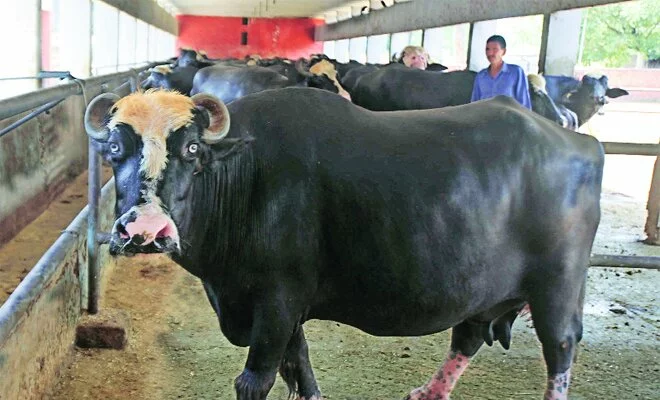Blue-eyed breed among buffaloes
Dark as any other buffalo but distinct because of its blue eyes, a white tuft on its tail and five white patches, one each on its forehead and feet, the Neeli Raavi used to thrive in undivided Punjab. Today, the bulk of its remaining population is in Pakistan while a few lakh survive on the Indian side, all in pockets of the border districts of Ferozepur, Taran Tarn, Gurdaspur, and only a few thousand of them purebreds.
Veterinary scientists looking to revive the lost population had their hopes boosted some weeks ago, when five purebred Neeli Raavis from Pakistan crossed the border and reached the farm of Punjab deputy chief minister Sukhbir Singh Badal. They would like the government to get such imports cleared for their research, too.
For the past two years, the Guru Angad Dev Veterinary Animal Sciences University has been working on a national project to save the rare, high-mulching breed. The Centre’s Open Nucleus Breeding System to Improve Sahiwal Cattle and Neeli Raavi Buffaloes in the State of Punjab, with a budget of Rs 2 crore, aims to rear at least 100 purebred Neeli Raavi buffaloes on a farm at Tarn Taran, from where semen can be supplied to Punjab farmers and exported to other states. The university is hoping for permission either for direct imports or for an exchange programme with Murrah bufafloes, which are found abundantly in Punjab.
Experts say the declining numbers, unless checked, will lead to the extinction of the Neeli Ravi, whose natural habitat has been in Punjab for more than 5,000 years. “Punjab can play a key role if we are allowed to get purebreds from Pakistan,” says Dr V K Taneja, vice chancellor of the university.
“Why we have not been able to complete the farm in Tarn Taran, despite land having been acquired two years earlier, is only because we are not getting the purebred. There are too few,” Taneja says. “Now when the deputy CM has called for some purebreds (four females and a male) from Pakistan, we will request him not only to grant us permission to import animals for our farm, but also maybe give us access to his animals for the time being, so that pure semen from the male can be used for research.” Sukhbir has already promised the university a heifer brought from Pakistan as a gift, Taneja says.
The Livestock Census of 2007 found the the population of breed had dropped to 3.47 lakh from 4.12 lakh in 2003. And only a few thousand now will have all defining characteristics of the breed, say experts; the rest will have been interbred with the Murrah. The Murrah comprises 93 per cent of Punjab’s buffalo population, the Raavi the rest.
Under its ongoing conservation plans, the Ministry of Animal Husbandry and Dairying is looking at Punjab to focus on the Neeli Raavi, with no such buffaloes in Haryana or other agricultural states.
“We are not only aiming at identifying farmers and providing them pure semen but also at introducing the breed in other states,” says Dr Taneja. “It is the male that is crucial; we need to get these from Pakistan. We have bought some animals for the farm, but very few of them are true breeds, as they are very hard to find in India.
The farm is way short of the targeted 100 purebreds. It has managed only 55 adult buffaloes, besides 29 female and 8 male calves, and not all of them are “true specimens”.
Their average annual milk yield was 2,350 kg, with a peak of 14.2 kg in a day. Six buffaloes crossed 3,000 kg with a peak of 18.5 kg; one of these crossed 4,200 kg. { Courtesy : Indian Express }




